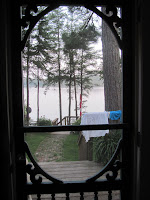
 Camp was a surreal experience in that I felt connected with nature in a way that I have missed in the prairies. There were small incidences of gender involved but the experience in the space was entirely genderless, just body with air, water and earth.
Camp was a surreal experience in that I felt connected with nature in a way that I have missed in the prairies. There were small incidences of gender involved but the experience in the space was entirely genderless, just body with air, water and earth.Within the social aspect of the camp, gender was brought in by the people attending. The masculinity oozed from my experience on the water because of the manly control of the water toys. Bob brought his fatherly protection while Sarah and I were out in the sailboat; he would drive up in his motorboat providing ‘assistance’ in hints and tips on how to control the sailboat and by providing the safety of a mechanical boat rather than sailboat. We were watched women while we were near Bob’s water.
While water held masculine attention, the camp itself seemed to attract the feminine, with all the women flocking to be baking, making meals and cleaning up afterwards in the female kitchen space, often the only occupied space of the interior of camp in the length of a day. While the men and women mingled for most of the resting and chatting, the women would cycle to the kitchen constantly, filling the space as to not allow any foreign bodies into their space, causing the men to retreat to the deck towards the barbeque or the boats.


Finally, sexuality and gender were obvious through bathing attire and the need to cover our bodies in a gender way while around the water.While in female groups we would not hesitate to strip our uncomfortable spandex, but the diversity of the group prevented as exposure of our bodies, despite the little difference a spandex bikini makes. This need to cover our bodies from the other gender continues to define our daily behaviours, which reflects our mental segregation of the two.